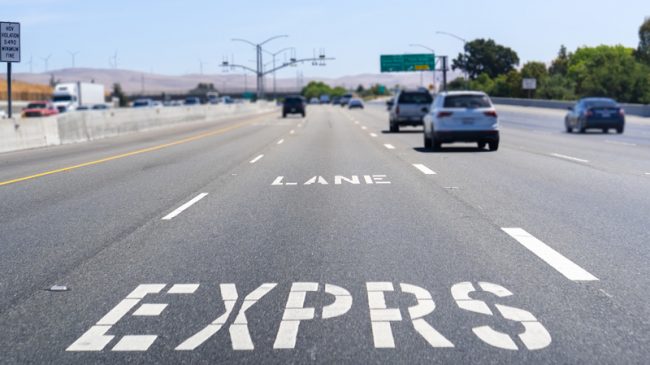More than 60 variably-priced express toll lanes are now in operation on U.S. highways. Most of these express lanes allow high-occupancy vehicles to use them either free or at a discount, while others charge all personal vehicles tolls but allow buses and vanpools to use them without charge. From the outset, some critics of priced lanes labeled them as “Lexus Lanes” because of their assumption that only upper-income people would pay to use them. Today, express toll lanes continue to frequently be described as unfair to lower-income drivers. But is this actually the case?
The transportation agencies (and sometimes private toll road companies) operating these toll lanes often present data showing the actual distribution of vehicles driven in the priced lanes. In case after case, by far the most common brands of vehicles using toll lanes are Toyotas, Hondas, Fords, and Chevrolets—not high-end luxury brands like Lexus. The distribution of vehicles using toll lanes is actually very similar to the distribution in the regular lanes of freeways.
Priced lanes create an option for freeway users who need or want a faster trip. Of all the priced-lane projects in the United States, only 28 percent were created by converting a former high-occupancy vehicle (HOV) lane to a priced land. And in all of those cases, the former carpool lane users can still use the lanes as carpool lanes.
Nearly three-fourths of the priced lane-miles in the United States are partially or entirely new capacity. These toll lanes were added to highways to offer motorists a choice between staying in the often-congested original lanes or deciding to use the added priced lanes if and when it is worth it to them to pay the variable price to get to their destination sooner.
Thanks to a major 2019 study from the University of Washington, we now know that for express lane commuters on I-405 in the Seattle region, it is the lowest-income quintile that gains the most benefits from the times they use these priced lanes. That study found that the net benefit from using the lanes (value of time savings minus the cost of the toll) is inversely proportional to the income category. In other words, the poor received the greatest net benefit while the wealthy received the least.
The University of Washington study found:
“Not surprisingly, higher income groups were found to use the facility more often and therefore to obtain a larger share of the benefits per user than lower income groups. However, lower income users were found to actually obtain higher net benefits per trip than higher income groups. This is because they used the facility more strategically. In addition, while lower income drivers paid to use the facility less often than higher income users, a large number of them used the facility at least periodically during the year.”
How can “lower-income drivers benefit more than higher-income drivers” per trip in the toll lanes?
Lower-income drivers primarily use the priced lanes in cases where being somewhere on time is very important to them, like getting to work on time to avoid being penalized or picking up their kids from day-care before costly late fees kick in.
Higher-income people tend to use the priced lanes more often, so they provide the large majority of the toll revenue, which makes it possible for the lanes to be there when occasional users need them.
HOV lanes began in the late 1960s, aiming to reduce gasoline use by encouraging commuters to carpool. But as the construction of HOV lanes grew during the 1970s, ‘80s, and ‘90s, carpooling steadily declined from something that 19.7 percent of commuters did in 1980 to just 9.8 percent in 2018. In response to the shift away from carpooling came the movement to convert HOV lanes to high-occupancy toll (HOT) lanes, and then to add express toll lanes that are increasingly financed by the toll revenues generated from variable pricing.
In other words, express toll lanes have been replacing failed HOV lanes (few of which are being built anymore). And the good news is that the toll lanes are not Lexus Lanes.
“(Drivers) are voluntarily choosing to subsidize the operation and the construction and the maintenance of (tolling lanes) for other people,” Washington State Transportation Center Director Mark Hallenbeck said. “From an equity perspective, that’s a really good thing.”
Express toll lanes offer benefits to highway users of all income levels.

